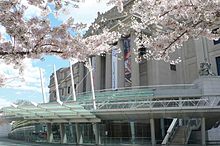See also: Economy of New York City
The USS North Carolina, launched at Brooklyn Navy Yard, June 1940
Newer buildings near East River State Park
Forty-four percent of Brooklyn's employed population, or 410,000 people, work in the borough; more than half of the borough's residents work outside its boundaries. As a result, economic conditions in Manhattan are important to the borough's jobseekers. Strong international immigration to Brooklyn generates jobs in services, retailing and construction.[67]
Since the late 20th century, Brooklyn has benefited from a steady influx of financial back office operations from Manhattan, the rapid growth of a high-tech and entertainment economy in DUMBO, and strong growth in support services such as accounting, personal supply agencies, and computer services firms.[67]
Jobs in the borough have traditionally been concentrated in manufacturing, but since 1975, Brooklyn has shifted from a manufacturing-based to a service-based economy. In 2004, 215,000 Brooklyn residents worked in the services sector, while 27,500 worked in manufacturing. Although manufacturing has declined, a substantial base has remained in apparel and niche manufacturing concerns such as furniture, fabricated metals, and food products.[68] The pharmaceutical company Pfizer was founded in Brooklyn in 1869 and had a manufacturing plant in the borough for many years that once employed thousands of workers, but the plant shut down in 2008. However, new light-manufacturing concerns packaging organic and high-end food have sprung up in the old plant.[69]
First established as a shipbuilding facility in 1801, the Brooklyn Navy Yard employed 70,000 people at its peak during World War II and was then the largest employer in the borough. The Missouri, the ship on which the Japanese formally surrendered, was built there, as was the Maine, whose sinking off Havana led to the start of the Spanish–American War. The iron-sided Civil War vessel the Monitor was built in Greenpoint. From 1968–1979 Seatrain Shipbuilding was the major employer.[70] Later tenants include industrial design firms, food processing businesses, artisans, and the film and television production industry. About 230 private-sector firms providing 4,000 jobs are at the Yard.
Construction and services are the fastest growing sectors.[71] Most employers in Brooklyn are small businesses. In 2000, 91% of the approximately 38,704 business establishments in Brooklyn had fewer than 20 employees.[72] As of August 2008, the borough's unemployment rate was 5.9%.[73]
Brooklyn is also home to many banks and credit unions. According to the Federal Deposit Insurance Corporation, there were 37 banks and 26 credit unions operating in the borough in 2010.[74][75]
The rezoning of Downtown Brooklyn has generated over US$10 billion of private investment and $300 million in public improvements since 2004. Brooklyn is also attracting numerous high technology start-up companies, as Silicon Alley, the metonym for New York City's entrepreneurship ecosystem, has expanded from Lower Manhattan into Brooklyn.[76]
Culture
See also: Culture of New York City and Media of New York City
The Brooklyn Museum on Eastern Parkway
Main article: Culture of Brooklyn
Brooklyn has played a major role in various aspects of American culture including literature, cinema, and theater. The Brooklyn accent
has often been portrayed as the "typical New York accent" in American
media, although this accent and stereotype are supposedly fading out.[77] Brooklyn's official colors are blue and gold.[78]Cultural venues
Brooklyn hosts the world-renowned Brooklyn Academy of Music, the Brooklyn Philharmonic, and the second largest public art collection in the United States, housed in the Brooklyn Museum.The Brooklyn Museum, opened in 1897, is New York City's second-largest public art museum. It has in its permanent collection more than 1.5 million objects, from ancient Egyptian masterpieces to contemporary art. The Brooklyn Children's Museum, the world's first museum dedicated to children, opened in December 1899. The only such New York State institution accredited by the American Alliance of Museums, it is one of the few globally to have a permanent collection – over 30,000 cultural objects and natural history specimens.
The Brooklyn Academy of Music (BAM) includes a 2,109-seat opera house, an 874-seat theater, and the art house BAM Rose Cinemas. Bargemusic and St. Ann's Warehouse are located on the other side of Downtown Brooklyn in the DUMBO arts district. Brooklyn Technical High School has the second-largest auditorium in New York City (after Radio City Music Hall), with a seating capacity of over 3,000.[79]





No comments:
Post a Comment